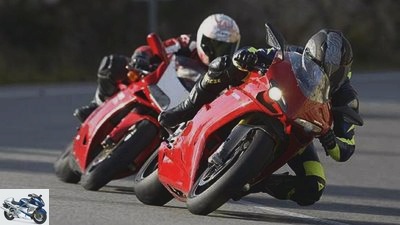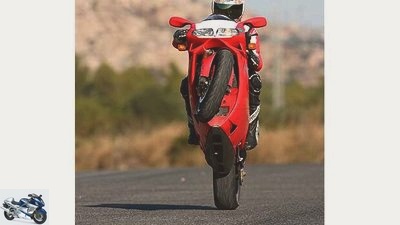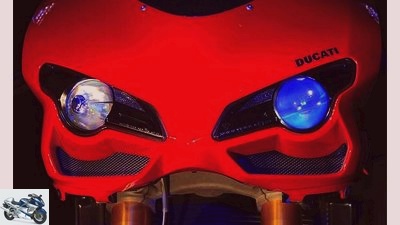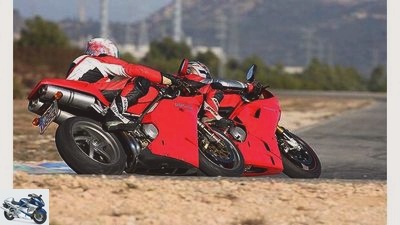Table of contents

motorcycles
Comparison test: Ducati 998S against 1098S
Comparison test: Ducati 998S against 1098S
power & Glory
Content of
After the unloved 999, the Ducati 1098S will inherit the 916/996/998 dynasty. An exciting thing: The Ducatisti await the 1098 with feverish eyes and damp hands. PS let the 998S and 1098S compete against each other.
Robert luck
02/12/2008
Of course, it is unfair to let your grandma play sports against your granddaughter. Just imagine your mother trying to win a hundred meters against your daughter. Grandma might have a chance in ice stock sport, knitting competitions or indoor halma, but in the sprint …
Thankfully, motorcycles are a little different from us humans. They do age too, but from a technical and not a biological point of view. If the cladding hangs lower than it should, age is hardly to blame. And you probably haven’t seen a strut with orange peel either. There are at least three reasons to let the 998S, the beloved 916/996 descendant, compete against the 1098S in a horsepower comparison: We find the first in the engine room, because in the 998 the Testastretta engine worked in the old chassis for the first time, in the 1098 the first Testastretta Evoluzione provides steam in the boiler. The second reason arises from heredity, more precisely: from Mendel’s second law, the law of splitting. In short, it says that the grandchildren have characteristics of their grandparents that were not visible in the generation in between. In German: The 1098S could have more of a real Ducati, i.e. the 998S, than its direct predecessor, the 999S.
The third reason to skip the 999 line came from the Ducati fans themselves. They punished them with ignorance because of their controversial appearance, stuck to the 916s and thus ensured a quick replacement of the triple-nine.
It is not for nothing that the Bolognese consciously resorted to design elements from the 916 series for the 1098S. Separate, slit-shaped double headlights with intake openings underneath at the front, dominant double tailpipes in the rear and a squeaky-clean aluminum single-sided swing arm are the most noticeable similarities. A tubular space frame is mandatory, as is the V-Twin with a 90 degree cylinder angle, which the Italians like to call an L because it is fixed in the frame in exactly the same way: with a standing and a lying cylinder. Other compulsory elements on a red one: multi-plate dry clutch, Ohlins spring elements, the best Brembo brakes, Magneti-Marelli injection and a cruelly high clutch operating force.
The engineers broke new ground in the development of the 1098S. Instead of handing the project over to a single manager, the first step was to create a specification that all project groups had to follow afterwards. The top priority: performance. Every part, every detail has been developed for performance on the racetrack. The result is impressive; Ducati had recognized that the gaps between the one-liter athletes had become very narrow and for the first time balanced a water-cooled Desmo-Twin over 1000 cc mark in order to ensure competitive performance for the production motorcycle. Pistons with a diameter of 104.0 millimeters move up and down 64.7 mm, resulting in a total displacement of 1099 cubic centimeters. Why is the 1098S not called the 1099S? The Italians are superstitious and did not want to follow up on the luckless 999 with a 9 at the end, but with the 8 on the successful 998. Cute, right?!

Let’s go: The old 998 also needs a knowledgeable throttle hand.
Superstition or not, the Testastretta-Evo is an animal. Well educated, with pleasant manners and little deviousness. The Evo has an even tighter valve angle than the once extreme 999R engine, and it accommodates fat 42-millimeter intake and 34-mm exhaust valves. These are kept in motion by relieved Desmo levers and sharp camshafts derived from the 999R. The rocker arms, in particular, which are responsible for closing the valves, have lost mass. Intake and exhaust ducts are wider than they are high, which saves overall height in the cylinder head with the same flow cross-section. Allegedly, this elliptical throttle valve system is closely based on that of the Desmosedici used in MotoGP.
With magnesium cylinder head covers, lighter gears in the transmission and primary drive as well as a lighter shift drum and many other details, the 1098 drive was able to slim down by 5 kg compared to the 999, which makes it the lightest superbike engine from Bologna despite the displacement bonus.
The 1098-V is not only light, but also strong. If it was not yet fully convincing at the presentation in the 1,800-meter-high South African Kyalami (see PS 1/2007), it marked the strong Max in the test motorcycle: the test bench attests to the 1100 with 160 crankshaft horsepower, which also squeezes off fat torque. From 6000 rpm there is always over 100 Nm, between 7500 and 9500 rpm even over 120. Not bad for a twin that has to do without high-quality premium parts. The 998S looks a little different: the original Testastretta with 998 cm3 The S version comes with fine titanium connecting rods, a sand-cast housing and, at the time, highly exclusive shower injection nozzles over the 54 mm suction throats. The thousands sends 140 hp to the crankshaft and does not forget the torque despite the sharp camshafts. The little one offers a wide plateau over 100 Nm from 6000 rpm and holds this up to 10000 rpm. However, it leaves it at a maximum of 108 Newton meters, while the 1100 pulls a whopping 123 of them, which have to struggle with a total of 19 kg less mass.
So let’s take a seat in the saddle of the 998S that we have been given by the company Kastenstop in Augsburg (www.boxenstop-motorrad.de) and start the engine. It goes smoothly and dignified from the first independent crankshaft rotation. The Desmo articulates itself clearly muffled from the standard pipes, the rumble from the airbox only occurs beyond the 6000 tours and when the throttle valves are wide open. On the narrow course in Calafat, Spain, the 998S engine can still inspire: From the low-speed days, it puffs forward vehemently and energetically runs up the ladder. It runs wonderfully soft and velvety, delivers its power in a razor-sharp dose and responds to every gas command without the slightest jerk. On the engine side, the 998S is still very good at doing business, at least on small courses, as this silky smooth response makes it child’s play to drive and recapture every single one of the 140 little horses. The clutch requires a forearm like Raimund Harmstorf once did, but the gears lock precisely and stay there.
Which is not the case with the 1098S, which is just over 1000 kilometers old. It also needs an ox on the clutch, but the gearbox does not reward the effort. Especially with hectic gear changes, the pilot often ends up in intermediate idle and has to roll through the curve with the clutch pulled and a knot in his stomach like a beginner. If the exit of the curve comes into view, he can apply for a propulsion level by pressing the gear lever again, engage the clutch and open the tap to get back the time lost on the straight.

Close to it: The 998 S cannot be shaken off
Wupps, too impetuous: the 1098S is already on the rear wheel in the first three gears. If you wind up gently, you can enjoy the power of the 1100 with a light front wheel, ride this phenomenal wave like a surfer off Maui. In general, the 1098S is more of the wild variety, on the engine side closer to a Suzuki GSX-R 1000 or a Kawasaki ZX-10R than to a Honda Fireblade. Anyone who rides the big Duc has to wrestle with the twin and must never underestimate it. But while the ten-ninja and the kilo-gixxer give up their power in a linear fashion, the Duc is making stormy progress from around six, six and a half thousand tours. In this area, the torque and power curve really take off, which is served up by the rising front including the cannonball feeling for the driver. That may not make you fast on the racetrack, but it makes you happy everywhere, as it is an immense pleasure to control this animal among yourself.
Another noticeable feature of the new engine: even when it is used on the racetrack in mild temperatures, it runs surprisingly cool. Its temperature never rose above 70 degrees Celsius, and the thermometer hardly showed 60 ° C on the country road.
The struggle with the cool twin is over at the end of every straight. When the throttle flaps are closed, the automated braking process begins: Bottom to the rear, the spacious bench allows a lot of weight to be shifted towards the rear. Pull the clutch, downshift and operate the impressive Brembo system. So that the twin doesn’t trip over the rear wheel when the clutch is engaged, the injection computer increases the idle gas slightly and cuts the load peaks that would lead to punching.
Two fingers are always sufficient for braking, the front dips slightly, the right hand carefully applies the pressure on the windows. The double-pane system at the front is almost too aggressive for the country road, but fully in its element on the racetrack. It compresses the Duc at any speed and can be opened creamy when turning in with increasing lean angle. A slight but only slightly annoying set-up moment is noticeable, which occurs with both the standard Pirelli Supercorsa Pro and the Pirelli Diablo Corsa III, which has been tried out as an alternative. The choice of line hardly makes it difficult, but the 1098S no longer instills that previously known and valued Ducati feeling in the pilot, the infinite trust in the front wheel. So times have changed in the Red Camp. Away from stoic line fidelity and maximum precision, to light-footed turning and quick change of lean angle.
The 998S acts very differently. Even with the modern, handling-enhancing Michelin Pilot Power 2CT, bringing you into an inclined position is an act of strength and coordination, but once angled the old one shoots through the curve like a roller coaster. The Showa fork and the Ohlins shock absorber do not report cryptically, but in plain language about the grip of the tires; the low-flyer can concentrate on the right line.

Never change a winning team: The new one is not based on the previous model.
The 1098S is more tangible, racing-oriented: While the sensitive fork can be adapted to the uneven Spanish route via widely opened damping valves, the shock absorber resists too much comfort. With its high spring rate and tight damping, it can perhaps convince in a team with a stiff racing tire, but for hobby racers and on Supercorsa Pro it clearly overshoots the target and is simply too tight in the record. If the compression damping is open to the maximum, you can still live with it on the circuit, but there’s definitely scythe on the country road: after 100 kilometers, even the most stubborn kidney stones say goodbye. In addition, the rebound adjustment is very difficult to achieve.
Whereby we would have arrived at the subject of service friendliness. Tire changes are a clean affair thanks to the single-sided swing arm, on the front wheel the screwdriver has to pay attention to the distances between the brake calipers, which allow different brake disc diameters. In addition, dismantling the front brake calipers requires caution and a steady hand: contact between the calipers and the forged wheel is almost inevitable, and damage to the paintwork on the wheel can quickly result.
If you want to remove the armor from a 1098S, you need patience and spit? and ideally a handy cordless screwdriver with a 3 hexagon socket bit: Believe it or not, 24 (in words: twenty-four) screws are required to get the keel and the two large casing halves down. For comparison: There are 14 quick-release fasteners and one screw on the 998S.
Another thing that doesn’t speak in favor of the 1098S is the fact that it lost retaining springs on the rear exhaust manifold during both the presentation and the test. A small thing, but an annoying one.

Nice to look at: both models have underseat systems.
Conclusion
The 1098S has power, the 998S Glory, recognition. No doubt: the Ducati 1098S will be the true heir to the 916 era. At the moment, the newcomer from Bologna is still missing a few manners: the power delivery and tuning of the Ohlins shock absorber have to be revised. The gearbox is too flawed to inspire.
That looks better with the 998S: It represents the high degree of maturity of a motorcycle that has been further developed for a long time. She suffers from her stubborn handling, but is otherwise still doing well; as long as it is not about championship honors, a stylish companion.
reviews
Ducati 998S
(2nd place, 13 points)
Engine:
The Thousand scores points smoothly and with great manners. His real 140 horses are enough, but the too long translation makes him seem undynamic.
Landing gear:
The 998S can keep up with the suspension elements. In terms of handling, it is losing a lot of ground and is far behind the new one.
Ergonomics:
The 998S is an old-school Duc. Deep handlebars and hardly any space to move lengthways ensure an uncomfortable racing posture over the long term.
Driving fun:
Ergonomically, the 998S is outdated, which sooner or later spoils the driving pleasure. Those who are capable of suffering will forgive her for this and still love her.
Verdict:
Queen of hearts, the 998 wins the emotional rating. Despite the powerful engine and crisp chassis, it is unfortunately a thing of the past from a sporting point of view.
Ducati 1098S
(1st place, 17 points)
Engine:
The 1100 engine is wild and impetuous because of its torque curve. Still not an impassable monster, but a very powerful engine.
Landing gear:
The shock absorber is too tight, but the fork is sensitive and has plenty of reserves. Outside the racetrack, the hindquarters torture the pilot.
Ergonomics:
The pilot has a lot of space, is sporty and comfortably accommodated. Unfortunately, it slips forward against the tank. The wind protection is bad, which leads to the deduction of points.
Driving fun:
On the 1098S, there is plenty of power and top-notch brakes available at all times. Except for the too hard strut, everything can be enjoyed without remorse.
Verdict:
The 1098S is a very good motorcycle. The shock absorber is still lacking fine-tuning, but the Nippon four-cylinder has got a tough opponent with it.
Measurements:
The curves of the 1098S are impressive even on paper. Especially if you’ve driven a 998S engine before and know how this little engine works.
The biggest problem with the 1098S is the inhomogeneous performance and torque curve. The drop in performance between 3500 and 4500 rpm would still be manageable, but at the same time the torque goes flat.
When driving, the thing is particularly noticeable on the country road: The abrupt use of power from 4500 rpm is immediately uncomfortable. Much better because the 998S makes it more linear. Always predictable and metered almost precisely, the old engine is superior to the new in terms of drivability. Unfortunately, its 140 hp fizzle out in the far too long secondary transmission.
Related articles
-
Comparison test Ducati Hypermotard old against new
Artist 22nd pictures jkuenstle.de 1/22 Ducati Hypermotard 1100 Evo (old) and Ducati Hypermotard 821 (new). jkuenstle.de 2/22 Ducati Hypermotard 821….
-
Comparison test BMW K 1300 R, Buell 1125 CR, Suzuki B-King, Yamaha Vmax
K 37 pictures Yamaha 1/37 First look at the device from all sides… Yamaha 2/37 Yamaha 3/37 Yamaha 4/37 Yamaha 5/37 Yamaha 6/37 Yamaha 7/37 What is…
-
Comparison test: BMW R 1200 GS, Ducati Hypermotard 1100 S, KTM 990 Supermoto
Jahn motorcycles Comparison test: BMW R 1200 GS, Ducati Hypermotard 1100 S, KTM 990 Supermoto Comparison test: BMW R 1200 GS, Ducati Hypermotard 1100 S,…
-
Track test Ducati 1198 S against KTM 1190 RC8 R.
Rossen Gargolov motorcycles Track test Ducati 1198 S against KTM 1190 RC8 R. Track test Ducati 1198 S against KTM 1190 RC8 R. New challenge KTM wants to…
-
Comparison test Aprilia RSV 1000 R Factory, Bimota DB7, Ducati 1098 S
K motorcycles Comparison test Aprilia RSV 1000 R Factory, Bimota DB7, Ducati 1098 S Comparison test Aprilia RSV 1000 R Factory, Bimota DB7, Ducati 1098 S…
-
fact motorcycles Comparison test: Honda CBR 600 RR, Kawasaki ZX-6R, Suzuki GSX-R 600, Triumph Daytona 675, Yamaha YZF-R6 Comparison test: Honda CBR 600…
-
Top test Ducati Multistrada 1100
Gargolov motorcycles Top test Ducati Multistrada 1100 Top test Ducati Multistrada 1100 Turboprop Clear the start for the greatest air-cooled Ducati of…
-
Top test Ducati Multistrada 620
Artist motorcycles Top test Ducati Multistrada 620 Top test Ducati Multistrada 620 Hidden size Just a mid-range motorcycle from Ducati or a real…
-
Comparison test: 600cc extreme athlete
K motorcycles Comparison test: 600cc extreme athlete Comparison test: 600cc extreme athlete Spear tips Content of They flaunt long lances at the end, are…
-
Comparison test Ducati Monster 1200 S, Honda Fireblade, Kawasaki Z 1000 SX, Suzuki GSX-S 1000 F
jkuenstle.de 27 pictures jkuenstle.de 1/27 The disguised Suzuki GSX-S 1000 F has to prove itself in the field of competitors. jkuenstle.de 2/27 Nice is…